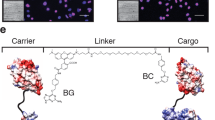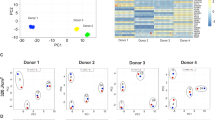Abstract
Small interfering RNAs (siRNAs) can be designed to specifically and potently target and silence a mutant allele, with little or no effect on the corresponding wild-type allele expression, presenting an opportunity for therapeutic intervention. Although several siRNAs have entered clinical trials, the development of siRNA therapeutics as a new drug class will require the development of improved delivery technologies. In this study, a reporter mouse model (transgenic click beetle luciferase/humanized monster green fluorescent protein) was developed to enable the study of siRNA delivery to skin; in this transgenic mouse, green fluorescent protein reporter gene expression is confined to the epidermis. Intradermal injection of siRNAs targeting the reporter gene resulted in marked reduction of green fluorescent protein expression in the localized treatment areas as measured by histology, real-time quantitative polymerase chain reaction and intravital imaging using a dual-axes confocal fluorescence microscope. These results indicate that this transgenic mouse skin model, coupled with in vivo imaging, will be useful for development of efficient and ‘patient-friendly’ siRNA delivery techniques and should facilitate the translation of siRNA-based therapeutics to the clinic for treatment of skin disorders.
This is a preview of subscription content, access via your institution
Access options
Subscribe to this journal
Receive 12 print issues and online access
$259.00 per year
only $21.58 per issue
Buy this article
- Purchase on Springer Link
- Instant access to full article PDF
Prices may be subject to local taxes which are calculated during checkout






Similar content being viewed by others
References
Kim DH, Rossi JJ . Strategies for silencing human disease using RNA interference. Nat Rev Genet 2007; 8: 173–184.
de Fougerolles A, Vornlocher HP, Maraganore J, Lieberman J . Interfering with disease: a progress report on siRNA-based therapeutics. Nat Rev 2007; 6: 443–453.
Dykxhoorn DM, Lieberman J . Knocking down disease with siRNAs. Cell 2006; 126: 231–235.
Hickerson RP, Smith FJ, Reeves RE, Contag CH, Leake D, Leachman SA et al. Single-nucleotide-specific siRNA targeting in a dominant-negative skin model. J Invest Dermatol 2008; 128: 594–605.
Schwarz DS, Ding H, Kennington L, Moore JT, Schelter J, Burchard J et al. Designing siRNA that distinguish between genes that differ by a single nucleotide. PLoS Genet 2006; 2: e140.
Nguyen T, Menocal EM, Harborth J, Fruehauf JH . RNAi therapeutics: an update on delivery. Curr Opin Mol Ther 2008; 10: 158–167.
Novobrantseva TI, Akinc A, Borodovsky A, de Fougerolles A . Delivering silence: advancements in developing siRNA therapeutics. Curr Opin Drug Discov Devel 2008; 11: 217–224.
Hengge UR . Gene therapy progress and prospects: the skin—easily accessible, but still far away. Gene Therapy 2006; 13: 1555–1563.
Khavari PA, Rollman O, Vahlquist A . Cutaneous gene transfer for skin and systemic diseases. J Intern Med 2002; 252: 1–10.
Leachman SA, Hickerson RP, Hull PR, Smith FJ, Milstone LM, Lane EB et al. Therapeutic siRNAs for dominant genetic skin disorders including pachyonychia congenita. J Dermatol Sci 2008; 51: 151–157.
Lane EB, McLean WH . Keratins and skin disorders. J Pathol 2004; 204: 355–366.
Leachman SA, Kaspar RL, Fleckman P, Florell SR, Smith FJ, McLean WH et al. Clinical and pathological features of pachyonychia congenita. J Investig Dermatol Symp Proc 2005; 10: 3–17.
Smith FJD, Kaspar RL, Schwartz ME, McLean WHI, Leachman SA . Pachyonychia congenita. Gene Rev 2006, www.genetests.org/profiles/pc.
Ra H, Piyawattanametha W, Mandella MJ, Hsiung PL, Hardy J, Wang TD et al. Three-dimensional in vivo imaging by a handheld dual-axes confocal microscope. Opt Express 2008; 16: 7224–7232.
Niwa H, Yamamura K, Miyazaki J . Efficient selection for high-expression transfectants with a novel eukaryotic vector. Gene 1991; 108: 193–199.
Robbins M, Judge A, Ambegia E, Choi C, Yaworski E, Palmer L et al. Misinterpreting the therapeutic effects of siRNA caused by immune stimulation. Hum Gene Ther 2008; 19: 991–999.
Kleinman ME, Yamada K, Takeda A, Chandrasekaran V, Nozaki M, Baffi JZ et al. Sequence- and target-independent angiogenesis suppression by siRNA via TLR3. Nature 2008; 452: 591–597.
Marques JT, Williams BR . Activation of the mammalian immune system by siRNAs. Nat Biotechnol 2005; 23: 1399–1405.
Zamanian-Daryoush M, Marques JT, Gantier MP, Behlke MA, John M, Rayman P et al. Determinants of cytokine induction by small interfering RNA in human peripheral blood mononuclear cells. J Interferon Cytokine Res 2008; 28: 221–233.
Judge A, MacLachlan I . Overcoming the innate immune response to small interfering RNA. Hum Gene Ther 2008; 19: 111–124.
Sioud M . RNA interference and innate immunity. Adv Drug Deliv Rev 2007; 59: 153–163.
Sioud M . Does the understanding of immune activation by RNA predict the design of safe siRNAs? Front Biosci 2008; 13: 4379–4392.
Miller VM, Xia H, Marrs GL, Gouvion CM, Lee G, Davidson BL et al. Allele-specific silencing of dominant disease genes. Proc Natl Acad Sci USA 2003; 100: 7195–7200.
van Bilsen PH, Jaspers L, Lombardi MS, Odekerken JC, Burright EN, Kaemmerer WF . Identification and allele-specific silencing of the mutant huntingtin allele in Huntington's disease patient-derived fibroblasts. Hum Gene Ther 2008; 19: 710–719.
Uitto J, Pulkkinen L . The genodermatoses: candidate diseases for gene therapy. Hum Gene Ther 2000; 11: 2267–2275.
Irvine AD, McLean WH . Human keratin diseases: the increasing spectrum of disease and subtlety of the phenotype-genotype correlation. Br J Dermatol 1999; 140: 815–828.
Bitko V, Musiyenko A, Shulyayeva O, Barik S . Inhibition of respiratory viruses by nasally administered siRNA. Nat Med 2005; 11: 50–55.
Heidel JD, Hu S, Liu XF, Triche TJ, Davis ME . Lack of interferon response in animals to naked siRNAs. Nat Biotechnol 2004; 22: 1579–1582.
Gorina R, Santalucia T, Petegnief V, Ejarque-Ortiz A, Saura J, Planas AM . Astrocytes are very sensitive to develop innate immune responses to lipid-carried short interfering RNA. Glia 2009; 57: 93–107.
Sawicki JA, Morris RJ, Monks B, Sakai K, Miyazaki J . A composite CMV-IE enhancer/beta-actin promoter is ubiquitously expressed in mouse cutaneous epithelium. Exp Cell Res 1998; 244: 367–369.
Tyner AL, Fuchs E . Evidence for posttranscriptional regulation of the keratins expressed during hyperproliferation and malignant transformation in human epidermis. J Cell Biol 1986; 103: 1945–1955.
Moll R, Franke WW, Schiller DL, Geiger B, Krepler R . The catalog of human cytokeratins: patterns of expression in normal epithelia, tumors and cultured cells. Cell 1982; 31: 11–24.
Sun TT, Tseng SC, Huang AJ, Cooper D, Schermer A, Lynch MH et al. Monoclonal antibody studies of mammalian epithelial keratins: a review. Ann NY Acad Sci 1985; 455: 307–329.
Wang Q, Ilves H, Chu P, Contag CH, Leake D, Johnston BH et al. Delivery and inhibition of reporter genes by small interfering RNAs in a mouse skin model. J Invest Dermatol 2007; 127: 2577–2584.
Matoltsy AG, Matoltsy MN . The chemical nature of keratohyalin granules of the epidermis. J Cell Biol 1970; 47: 593–603.
Sandilands A, Sutherland C, Irvine AD, McLean WH . Filaggrin in the frontline: role in skin barrier function and disease. J Cell Sci 2009; 122 (Pt 9): 1285–1294.
Hengge UR, Pfutzner W, Williams M, Goos M, Vogel JC . Efficient expression of naked plasmid DNA in mucosal epithelium: prospective for the treatment of skin lesions. J Invest Dermatol 1998; 111: 605–608.
Hengge UR, Walker PS, Vogel JC . Expression of naked DNA in human, pig, and mouse skin. J Clin Invest 1996; 97: 2911–2916.
Hickerson RP, Vlassov AV, Wang Q, Leake D, Ilves H, Gonzalez E et al. Stability study of unmodified siRNA and relevance to clinical use. Oligonucleotides 2008; 18: 345–354.
Smith FJ, Hickerson RP, Sayers JM, Reeves RE, Contag CH, Leake D et al. Development of therapeutic siRNAs for pachyonychia congenita. J Invest Dermatol 2008; 128: 50–58.
Ikram MS, Neill GW, Regl G, Eichberger T, Frischauf AM, Aberger F et al. GLI2 is expressed in normal human epidermis and BCC and induces GLI1 expression by binding to its promoter. J Invest Dermatol 2004; 122: 1503–1509.
Ra H, Piyawattanametha W, Taguchi Y, Lee D, Mandella MJ, Solgaard O . Two-dimensional MEMS scanner for dual-axes confocal microscopy. J Microelectromech Syst 2007; 16: 969–976.
Judge AD, Sood V, Shaw JR, Fang D, McClintock K, MacLachlan I . Sequence-dependent stimulation of the mammalian innate immune response by synthetic siRNA. Nat Biotechnol 2005; 23: 457–462.
Sioud M . Induction of inflammatory cytokines and interferon responses by double-stranded and single-stranded siRNAs is sequence-dependent and requires endosomal localization. J Mol Biol 2005; 348: 1079–1090.
Acknowledgements
This study was funded in part by grants from the National Institutes of Health (R43AR055881, RLK and U54 CA105296-01, CHC). We thank Irwin McLean and Birgitte Lane for critical review of the manuscript, Heini Ilves, Manuel Flores and Maria Fernanda Lara for technical support, and Mohammed Ikram and Mike Philpott for the kind gift of phK14 plasmid. EGG is the recipient of a PC Project fellowship.
Author information
Authors and Affiliations
Corresponding author
Additional information
Supplementary Information accompanies the paper on Gene Therapy website (http://www.nature.com/gt)
Rights and permissions
About this article
Cite this article
Gonzalez-Gonzalez, E., Ra, H., Hickerson, R. et al. siRNA silencing of keratinocyte-specific GFP expression in a transgenic mouse skin model. Gene Ther 16, 963–972 (2009). https://doi.org/10.1038/gt.2009.62
Received:
Revised:
Accepted:
Published:
Issue Date:
DOI: https://doi.org/10.1038/gt.2009.62
Keywords
This article is cited by
-
Imaging of Tumor-Associated Macrophages in a Transgenic Mouse Model of Orthotopic Ovarian Cancer
Molecular Imaging and Biology (2017)
-
Epigenetics of amphetamine-induced sensitization: HDAC5 expression and microRNA in neural remodeling
Journal of Biomedical Science (2016)
-
Non-Invasive Intravital Imaging of siRNA-Mediated Mutant Keratin Gene Repression in Skin
Molecular Imaging and Biology (2016)
-
Gene Silencing in Skin After Deposition of Self-Delivery siRNA With a Motorized Microneedle Array Device
Molecular Therapy - Nucleic Acids (2013)
-
Progress Toward In Vivo Use of siRNAs-II
Molecular Therapy (2012)



